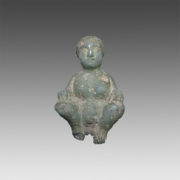Anepigraphic Scarab
Anepigraphic Scarab
The scarab is placed on a flat, elliptical base; the bottom has no inscription. Characterized by stylized, though complete and accurate shapes, this beetle shows elegant features that indicate the details of the anatomy.
4th century B.C.
L : 4.9 cm
In stock
Product Description
The scarab is placed on a flat, elliptical base; the bottom has no inscription. Characterized by stylized, though complete and accurate shapes, this beetle shows elegant features that indicate the details of the anatomy, such as the finely incised elytra, the well-modeled clypeus (head) and the three-dimensional legs.
Very common in the desert, the scarab was extremely popular in the religious beliefs of ancient Egypt. A sacred animal from the Thinite period, it metaphorically became the symbol of the rising sun, as it was thought to push the solar disk with its hind legs in the same way that real scarabs roll balls of dung in which they lay their eggs before burying them. At the same time, it was a symbol of rebirth and regeneration, and was read as the ideogram Khepri, which means “to become”.
With or without inscription, made of faience, of stone or of other materials, scarabs represented for men an amulet that breathed life. There were no mummies without scarabs sewn or simply inserted between the strips.The larger examples were placed on the chest and called “heart scarabs”; they replaced the real heart of the deceased, which found its final resting place in one of the four canopic jars. According to Egyptian beliefs, the heart (the seat of reason) had to testify on the life of the deceased in front of the court of Maat and to allow him/her, if the evidence was favorable, to enter the afterlife.






